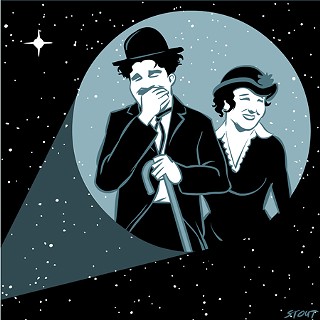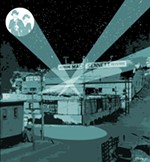Letters at 3AM: Of Mayhem and Delight
The Keystone films, especially those of Charles Chaplin, reflected the present and heralded the future
By Michael Ventura, Fri., Dec. 3, 2010
Two people, a woman and a man, are in a state of delight. It dazzles you to see them. You are seeing happiness, and you almost never see that, not really, not all the way. They respond to each other with an almost animal intimacy that is delicate, as cats are deftly delicate when at play. These are intelligent people, but you sense their awareness of what intelligence alone cannot grasp. Watching, I say aloud: "This is what it really means to be human. These two, in this moment. This is why it's all worth it."
I feel this not because they are a "couple" (they may not be) but because of their delighted understanding of the moment and each other.
They are actors in a film, but this behavior is not acting. They acted up to this moment, but this, now, is beyond acting. And before you can register it fully, it's gone. And that, too, is appropriate and true.
I stood up, walked up and down, lit a cigarette, grinned ear to ear, glowing with what they'd given me and feeling an expansive gratitude for their reminder of this secret of life, which we all know and forget, over and over: the profound delight of perfect, playful understanding which love, friendly or romantic, always seeks, sometimes finds, and rarely keeps.
The actors are Charles Chaplin and Mabel Normand. Chaplin directed the film.
For decades, this film, "Gentlemen of Nerve," was virtually impossible to see. It was released 96 years ago under the rubric "Keystone – A Farce Comedy." Rare prints survived here and there, none completely intact. The Chaplin Keystones available for viewing fared hardly better. We've watched grainy, blurry, choppy copies, impossible to enjoy fully or judge fairly.
But now a new 4-disc set, Chaplin at Keystone, presents 35 of the 37 films in which Chaplin appeared during his first year before the camera: 1914. Producer Jeffrey Masino and renowned film preserver David Shepard have collected, restored, and combined the best elements of many prints so that most of these films look as good as when they were first screened. Chaplin's Keystone achievement can at last be seen for what it was and is: a shocking, adventurous creation.
Alas, the set's booklet, by Jeffrey Vance, is rife with inaccuracies and suppositions presented as fact without supporting contexts. For instance, Vance states: "The birth of modern screen comedy occurred when Chaplin donned his derby hat." Those words shunt aside films that go back to the 1890s and, most of all, the works of Mack Sennett and Mabel Normand from 1911 onward. Several credits Vance provides for the films' directors are seriously open to question, and his cast lists are incomplete. Worse, Vance writes as though Sennett's Keystone studio, his self-named "university of nonsense," was merely incidental to the cinema of Charles Chaplin.
Sennett's concerns, shared infectiously by Chaplin, remain far more immediate than those of their contemporary, D.W. Griffith. Griffith's sense of story was stuck in the 19th century. Victorian to the core, Griffith and his circle mightily disapproved of the irreverence Sennett relished. Griffith star Blanche Sweet: "We avoided the Sennett films. ... If you did extra work on a Sennett one- or two-reeler in those days, you certainly didn't talk about it."
But Sennett sensed the essence of the 20th century. It was all about movement and about turning every assumed standard inside-out.
For Griffith, a happy ending meant marriage. At Sennett's Keystone, marriage was invariably presented as institutionalized hell. In Chaplin's Keystone films, every husband is interested in any woman who is not his wife, and wives are often equally susceptible to sexual whims. Boyfriends and girlfriends are so fickle that rarely does a couple's walk in the park end with the same partner. Spouses who enforce fidelity are mercilessly mocked. Mayhem in relationships is the (dis)order of the day.
We of the 21st century forget the shock and titillation a 1914 audience felt when, in "Mabel's Strange Predicament," Chaplin ogles Mabel clad only in pajamas, her long hair loose and wild. Or, even more shocking: Mabel, a single maiden, checks into a hotel alone! And intends to see her intended in her room, before marriage! (Those are 1914 exclamation points.) Books describing such behavior were often banned. Sennett's formula: If you keep it moving and keep it funny, you can get away with anything.
In Chaplin's Keystones, women dare to smoke, though in some states that was against the law. In an era of elaborately clothed women, Keystone's gals showed not only their ankles but lots of leg. Domestic violence was common and unpoliced back then, but Keystone women (especially Mabel Normand) did not stand still for it; when hit and kicked, they hit and kicked back harder. Griffith's women were victims saved by men; Sennett's women gave as good as they got and usually won.
At Keystone, Chaplin played with sensuality as he never would again. In "The Face on the Bar Room Floor," Chaplin paints portraits. In his studio, Cecile Arnold, the actress playing the subject of his portrait, is draped flimsily in white. Just to her right is a statue of a naked woman and, just to the right of that, another. Lower screen-right, still another. This is full frontal nudity, folks, with pubic hair more than just suggested. Chaplin frames his foreground action so that we never lose sight of the naked statues. Later, he's a drunk remembering his glory days. With a piece of chalk he crawls across a barroom floor drawing circles that purport to be the face of his lost love, reducing the love and sensuality he'd known to a furious, nihilistic zero. This film isn't a comedy. There's no word for what it is.
Keystone's directors experimented audaciously. In March 1914, Sennett and George Nichols directed Chaplin and Minta Durfee Arbuckle in "Cruel, Cruel Love," shooting close-ups nearly a year before Griffith's full employment of close-ups in The Birth of a Nation. Normand, directing herself and Chaplin in April 1914's "Caught in a Cabaret," shot an extended close-up two-shot. Chaplin shot close-ups in "His New Profession," "Those Love Pangs," and "Dough and Dynamite," as well as the marvelous two-shot close-up in "Gentlemen of Nerve," all released months before Birth. In Birth, Griffith featured close-ups as portraiture, outside the action, in the style of classical painting. The Keystone directors used such shots within the action, as part of the action, as filmmakers still do.
In Griffith's stories, the movies, as a social phenomenon, are absent. At Keystone, the movies are part of the story and are the story. Chaplin's "Kid Auto Races at Venice, Cal." and "A Busy Day" are about the fascination of the movie camera. "A Film Johnnie" and "The Masquerader" are behind-the-scenes movie-studio farces. "Those Love Pangs" ends with Chaplin in a movie theatre, one arm around Cecile Arnold and another around Vivian Edwards, but their former boyfriends charge in, pick up Chaplin, and throw him through the movie screen. The end. That's what happens to movie stars. Metaphorically, if you like, they get thrown through their own screens.
Sennett's Tillie's Punctured Romance is cinema's first feature-length comedy. Mabel Normand and Chaplin play thieving hustlers. In a brilliantly acted scene, they go to the movies and view a comedy about people like themselves. Shocked and dismayed at how they appear to the world, they skedaddle. Deconstruction? Postmodern? The year is 1914.
Director-producer Mack Sennett took a stand, and Chaplin followed his lead. Their pictures presented all that we cannot escape: the desires that make us what we are, the images that goad us toward what we want to be, and the happiness we sometimes stumble upon, if only for a little while. The movement was frenzied, and the only rule was that anything goes.
The films of Keystone, especially Chaplin's, heralded the 20th century, the 21st, and what's to come. As Sennett said when directing, "All right, kids, let's make it move."
Oops! In the Dec. 3 "Letters @3AM" column, "Of Mayhem and Delight," Michael Ventura states that there were 37 Charles Chaplin films made for Keystone Films in 1914 when, in fact, there were 36.










